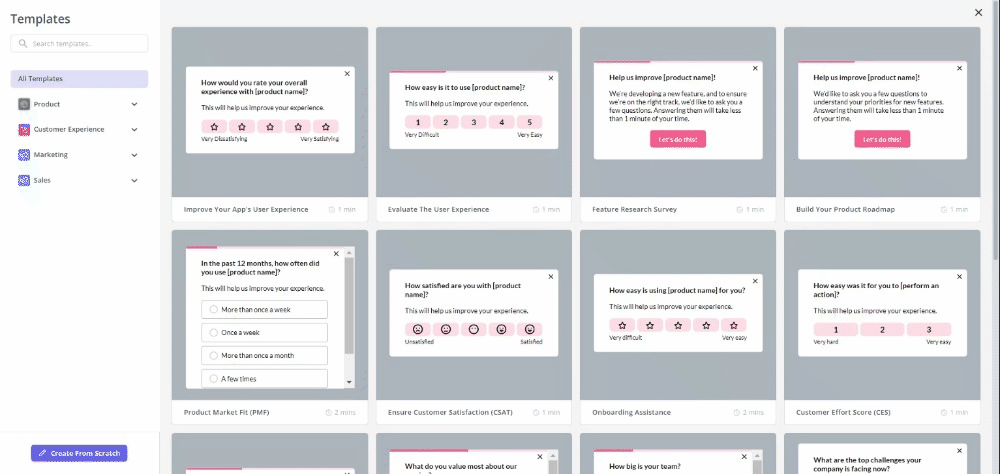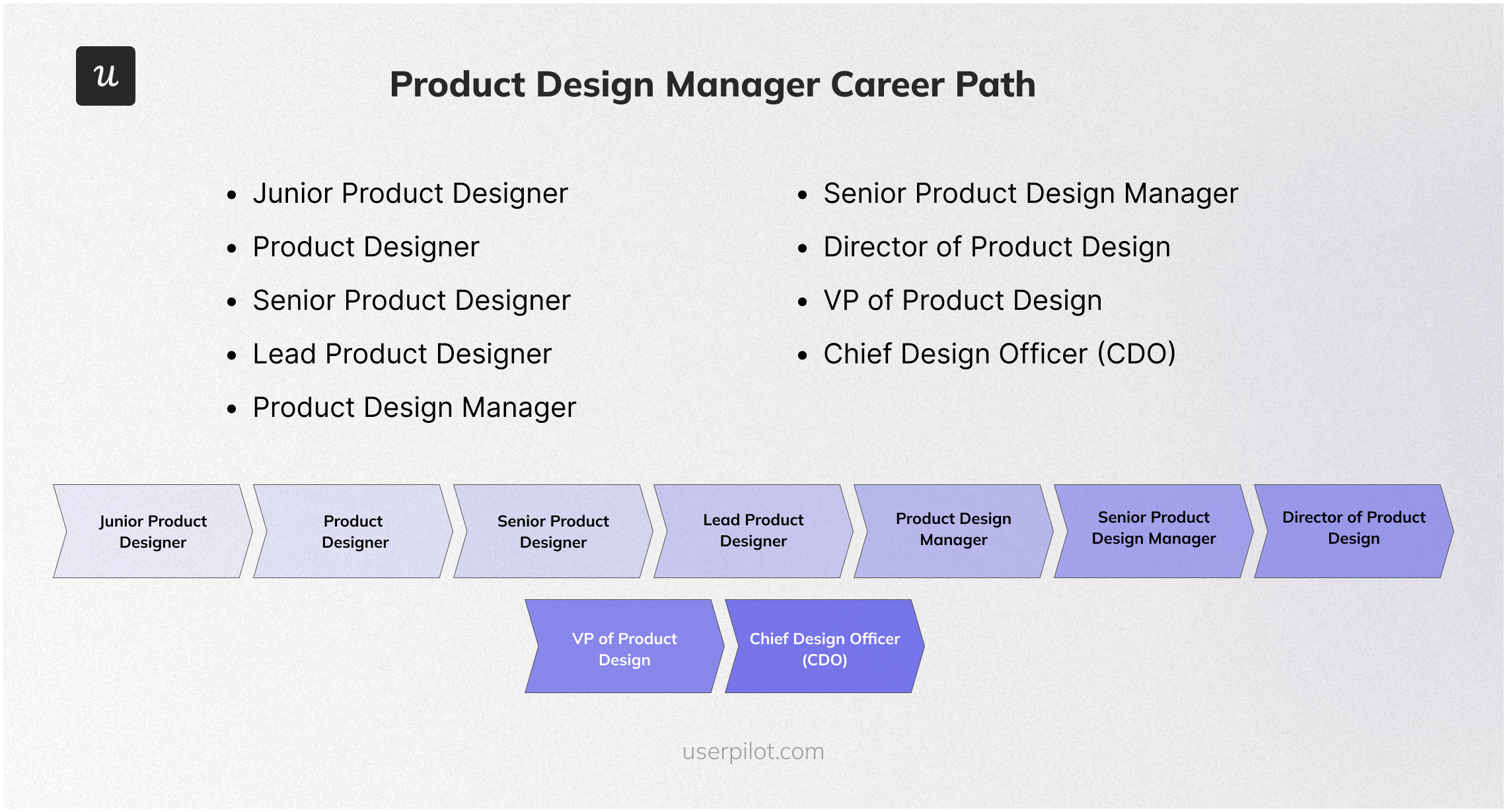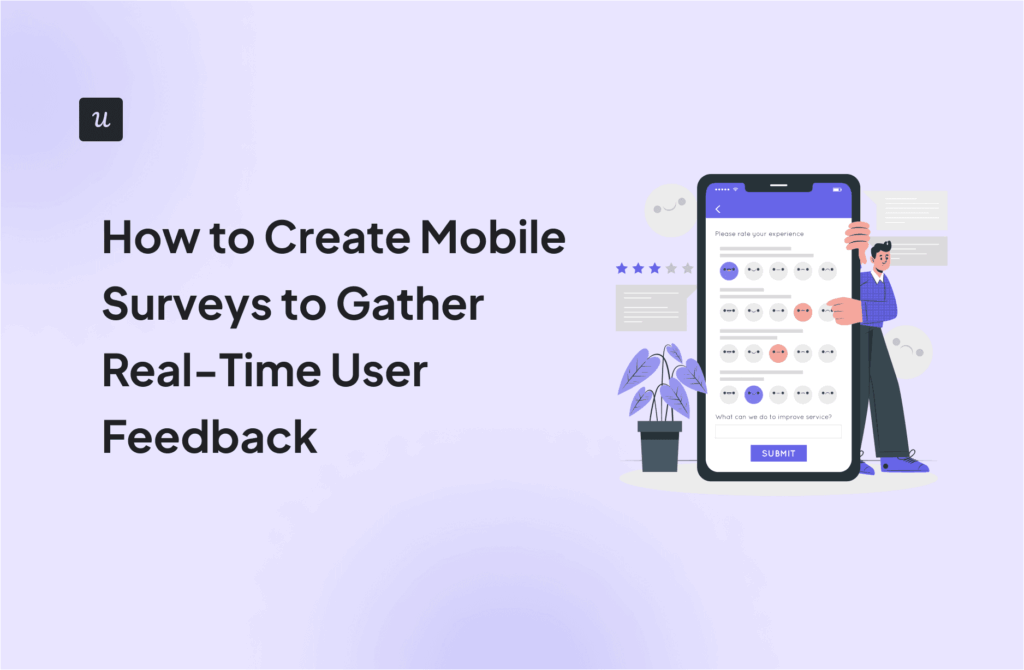![How to Become a Product Design Manager [+Tools and Resources]](https://blog-static.userpilot.com/blog/wp-content/uploads/2024/07/How-to-Become-a-Product-Design-Manager-Tools-and-Resources.png)
Try Userpilot Now
See Why 1,000+ Teams Choose Userpilot

How to become a product designer manager?
-
- A product design manager in the SaaS industry oversees the design and development of software products. Their primary role involves leading a team of designers to create user-friendly and aesthetically pleasing interfaces.
- Here is what a typical product design manager career path looks like:
- Junior product designer
- Product designer
- Senior product designer
- Lead product designer
- Product design manager
- Senior product design manager
- Director of product design
- VP of product design
- Chief design officer
- To become a product design manager, start by obtaining a bachelor’s degree in a relevant field such as graphic design, industrial design, or human-computer interaction.
- Pursue internships or entry-level positions in design to gain practical experience and build a robust portfolio. Focus on developing strong skills in user experience (UX) and user interface (UI) design, utilizing design tools like Sketch, Figma, and Adobe Creative Suite.
- Product design managers can leverage a variety of tools to streamline their workflows and improve product outcomes. Userpilot helps enhance user onboarding and engagement, while Monday.com and Jira Software assist in project management, etc.
- Looking into tools for product design managers? Userpilot is an all-in-one product platform with engagement features and powerful analytics capabilities. Book a demo to see it in action!
What is a product design manager?
A product design manager in the SaaS industry oversees the design and development of software products. Their primary role involves leading a team of designers to create user-friendly and aesthetically pleasing interfaces.
They collaborate closely with product managers, developers, and stakeholders to ensure the design aligns with business goals and user needs.
Additionally, they focus on optimizing the user experience and staying updated with the latest design trends and technologies. Their goal is to deliver a seamless and engaging user experience that enhances the product’s functionality and appeal.
Product design manager’s main responsibilities
Product design manager plays a critical role in shaping the user experience and visual design of SaaS products. Here are the main responsibilities and duties:
- Leading and mentoring a team of designers, fostering a collaborative and innovative design environment.
- Collaborating with product managers and developers to define design requirements and objectives specific to SaaS products.
- Overseeing the entire design process from user research and wireframing to prototyping and final implementation.
- Ensuring design consistency and adherence to brand guidelines across all SaaS products.
- Conducting usability testing and gathering user feedback to iterate and improve design solutions.
- Creating and maintaining design systems and component libraries to ensure efficiency and consistency in product design.
- Staying updated with the latest design trends, tools, and technologies relevant to the SaaS industry.
- Working closely with engineering teams to ensure designs are implemented accurately and efficiently.
- Balancing user needs, business goals, and technical constraints to deliver optimal design solutions.
- Managing project timelines, deliverables, and resources to ensure timely and high-quality output.
- Advocating for user-centric design principles and best practices within the organization.
This list encompasses the core responsibilities of ensuring the effective design and delivery of high-quality SaaS products and enhancing user experience and product functionality.
Product design manager career path
Here is what a typical product design manager career path looks like:
- Junior product designer: Entry-level position focusing on assisting senior designers, creating design components, and conducting user research. To progress in this position, you need to build a strong portfolio, learn from senior designers, master design tools, and seek feedback to improve your skills.
- Product designer: Involved in designing product interfaces, conducting usability tests, and collaborating with cross-functional teams. To progress in this position, you need to take on more complex projects, develop a deep understanding of user experience (UX) principles, and start leading smaller design initiatives.
- Senior product designer: Leads major design projects, mentors junior designers, and plays a key role in strategic design decisions. In this position, you need to focus on leadership skills, contribute to creating design systems, and build strong relationships with product managers and developers.
- Lead product designer: Oversees the design team, ensures design consistency across projects, and aligns design goals with business objectives. Your primary focus needs to be on developing project management skills, driving innovation within the team, and engaging in high-level strategic planning.
- Product design manager: Manages the design team, coordinates design projects, and ensures alignment with business goals and user needs. To progress in this position, learn to enhance leadership and managerial skills, stay updated with industry trends, and focus on optimizing team performance and design processes.
- Senior product design manager: Manages larger design teams, oversees multiple projects, and plays a critical role in company-wide design strategy. A career progression tip would be to develop a vision for the design department, influence company design culture, and mentor upcoming leaders within the team.
- Director of product design: Sets the overall design direction for the company, collaborates with top executives, and ensures the design vision aligns with the company’s mission. Focus on strategic leadership, expand your influence across departments, and drive the company’s design innovation.
- VP of product design: Responsible for the entire design organization, driving design excellence and contributing to the overall business strategy. Strengthen executive leadership skills, maintain a forward-thinking design vision, and foster a culture of creativity and innovation.
- Chief design officer: Top-level executive overseeing all design aspects of the company, ensuring cohesive design strategy across all products and services. Focus on visionary leadership, drive company-wide design integration, and champion design as a core business value.
By progressing through these roles, continuously developing skills, and taking on increasing responsibilities, one can advance to higher positions within the product design field.
How to become a product design manager?
To become a product design manager, start by obtaining a bachelor’s degree in a relevant field such as graphic design, industrial design, or human-computer interaction.
Pursue internships or entry-level positions in design to gain practical experience and build a robust portfolio. Focus on developing strong skills in user experience (UX) and user interface (UI) design, utilizing design tools like Sketch, Figma, and Adobe Creative Suite.
Additionally, gaining experience in project management and leadership can be beneficial. As you advance, seek roles with increasing responsibility and consider obtaining certifications in design or project management to further enhance your qualifications.
Building a diverse portfolio and demonstrating the ability to lead and collaborate effectively will position you for success as a product design manager.
What skills should a product design manager have?
A product design manager must possess a diverse set of skills to lead a design team and create exceptional SaaS products effectively. These skills ensure the delivery of user-centric, aesthetically pleasing, and functional designs.
Here are the essential skills for this role:
- User Experience (UX) Design: Expertise in creating intuitive and engaging user experiences through thorough research, user testing, and iterative design processes.
- User Interface (UI) Design: Strong proficiency in crafting visually appealing and consistent interfaces using design tools like Sketch, Figma, and Adobe Creative Suite.
- Leadership and Mentorship: Ability to lead, inspire, and mentor a team of designers, fostering a collaborative and innovative work environment.
- Collaboration: Strong skills in working closely with product managers, developers, and other stakeholders to align design objectives with business goals and technical constraints.
- Project Management: Proficiency in managing design projects, including setting timelines, defining deliverables, and allocating resources to ensure timely and high-quality output.
- Communication: Excellent verbal and written communication skills to effectively convey design concepts, present ideas, and articulate design decisions.
- Problem-Solving: Strong analytical and creative problem-solving abilities to address user needs, business challenges, and technical limitations.
- Attention to Detail: Keen eye for detail to ensure precision and consistency in design elements, contributing to a polished and professional end product.
- Design Systems: Experience in creating and maintaining design systems and component libraries to ensure efficiency and consistency across products.
- Knowledge of Front-End Technologies: Basic understanding of HTML, CSS, and JavaScript to facilitate better collaboration with engineering teams and ensure design feasibility.
- Adaptability: Ability to stay updated with the latest design trends, tools, and technologies and adapt to changing project requirements and user feedback.
These skills collectively enable a product design manager to lead a design team effectively and deliver outstanding SaaS products that meet user and business needs.
Best certifications for product design managers
For aspiring and experienced product design managers, certifications and specialized courses offer a valuable way to validate expertise, gain new skills, and demonstrate commitment to the field.
The following certifications and courses are highly regarded in the industry and can significantly enhance a product design manager’s career prospects:
- New Product Development Professional (NPDP) Certification: Offered by the Product Development and Management Association (PDMA), this is one of the most globally recognized certifications for product design and development professionals. It covers a broad range of topics, from ideation to launch, and demonstrates your expertise in the entire product development process.
- Certified Professional in Design Management (CPDM): Offered by the Design Management Institute (DMI), this certification is specifically geared towards design managers and leaders. It covers a wide range of topics, including design strategy, design thinking, and design leadership, and demonstrates your ability to lead and manage design teams effectively.
- Agile Certified Product Manager and Product Owner (PMI-ACP): Offered by the Project Management Institute (PMI), this certification focuses on agile methodologies and their application to product management. It demonstrates your ability to manage product development in an agile environment and is becoming increasingly important as more companies adopt agile practices.
- IBM Product Manager Professional Certificate: This 7-course program covers the full product lifecycle, from ideation to launch and beyond. It’s designed for beginners and requires no prior experience.
- AI Product Management Specialization by Duke University’s Pratt School of Engineering: This is a great course for product design managers who want to learn more about artificial intelligence and machine learning. It covers the basics of how machine learning works and how it can be applied to solve problems in a variety of industries. The course also teaches you how to lead machine learning projects and design human-centered AI products.
Best resources for product design managers
To excel as a product design manager, leveraging various resources such as books, training programs, podcasts, and blogs can provide valuable insights and keep you updated on industry trends and best practices.
Best books for product design managers
Reading books by industry experts can provide deep insights and practical knowledge about product design and management:
- “The Design of Everyday Things” by Don Norman – A must-read for understanding the principles of good design and human-centered design.
- “Hooked: How to Build Habit-Forming Products” by Nir Eyal – This book explores the psychology behind user habits and how to create products that keep users engaged.
- “Lean UX: Designing Great Products with Agile Teams” by Jeff Gothelf and Josh Seiden – Offers practical advice on integrating UX design with Agile methodologies.
- “Inspired: How To Create Products Customers Love” by Marty Cagan – A comprehensive guide on product management and creating products that delight customers.
- “Sprint: How to Solve Big Problems and Test New Ideas in Just Five Days” by Jake Knapp – Provides a step-by-step process for solving problems and testing ideas quickly.
Best webinars for product design managers
Participating in webinars can offer real-time learning and insights from industry experts.
- Userpilot Webinars – Offers a range of webinars focused on user onboarding, engagement, and product growth.
- Nielsen Norman Group Trainings – Provides expert insights on various UX topics, including usability, user research, and interaction design.
- UX Design Institute Webinars – Covers topics related to UX design principles, methodologies, and career advice.
- Adobe XD Webinars – Offers tutorials and deep dives into design tools and best practices using Adobe XD.
- InVision Webinars – Features discussions with industry experts on design, collaboration, and product management.
Best blogs for product design managers
Following blogs can help you stay updated on the latest trends, tips, and best practices in product design and management.
- Userpilot Blog – Offers insights on user onboarding, product growth, and UX design.
- Nielsen Norman Group Blog – Provides in-depth articles on usability, user experience, and design research.
- Smashing Magazine – Covers a wide range of topics, including UX design, web development, and product management.
- UX Collective – A community-driven platform with articles on UX design, product design, and industry trends.
- IDEO Blog – Shares stories and insights from one of the leading design firms in the world.
Best podcasts for product design managers
Listening to podcasts is a convenient way to stay informed and inspired by industry leaders while on the go.
- “The Design Better Podcast” – Interviews with design leaders discussing the craft and business of design.
- “High Resolution” – Features in-depth conversations with design leaders from top companies.
- “The UX Podcast” – Discusses UX design, strategy, and how to integrate UX into business practices.
- “Product to Product” – A podcast for product people, by product people, covering various aspects of product management and design.
- “Product Love” – Focuses on product management and features interviews with product leaders.
Best tools for product design managers
As a product design manager, leveraging a diverse set of tools is crucial for managing projects, enhancing customer experience, ensuring customer success, and creating exceptional UX/UI designs.
Here are some of the key tools every product design manager should have in their tech stack:
- Best tool for User Onboarding and Engagement – Userpilot: Userpilot is designed to help product managers create personalized in-app experiences and guide users through the product, enhancing user engagement and retention. Product design managers can create different experiences without any need to code.
- Best tool for Project Management – Monday: Monday.com offers a flexible and visual way to manage projects and tasks, helping teams collaborate efficiently and stay on track with deadlines.
- Best tool for Product Management – Jira Software: Jira Software is a powerful tool for product management, offering robust features for tracking and managing development tasks, sprints, and releases.
- Best tool for Customer Experience – Zendesk: Zendesk provides comprehensive customer support solutions, enabling teams to manage customer inquiries, feedback, and support tickets effectively.
- Best tool for Customer Success – ClientSuccess: ClientSuccess helps customer success teams manage and measure customer relationships, ensuring customers achieve their desired outcomes with the product.
- Best tool for UX/UI Design – Figma: Figma is a cloud-based design tool that allows for real-time collaboration, making it ideal for teams working together on UX/UI design projects.
- Best tool for UX/UI Design – Sketch: Sketch is a vector graphics editor focused on digital design, offering a wide range of plugins and integrations to streamline the design process.
- Best tool for Data Analytics – Tableau: Tableau provides powerful data visualization capabilities, allowing teams to analyze and present data in an intuitive and visually appealing way.
- Best tool for Data Analytics – Power BI: Power BI is a business analytics service by Microsoft that delivers insights through interactive dashboards and reports, helping teams make data-driven decisions.
- Best tool for UX/UI Design – InVision Studio: InVision Studio is a comprehensive design tool that offers advanced prototyping and animation capabilities, enabling designers to create interactive and high-fidelity prototypes.
Product design manager FAQs
- What is the difference between a product manager and a product design manager? A product manager focuses on the overall strategy, roadmap, and business objectives of a product, while a product design manager focuses on the user experience (UX) and visual design aspects, ensuring the product is user-friendly and aesthetically pleasing.
- How do product designers and product managers work together? Product designers and product managers collaborate closely to align design with business goals, conduct user research, and ensure the final product meets both user needs and business objectives.
- Is product design a good career? Yes, product design is a rewarding career that offers opportunities for creativity, problem-solving, and the ability to make a significant impact on user experience and business success.
- What degree do you need to be a product manager? A degree in business administration, marketing, computer science, or a related field is typically needed to become a product manager, along with relevant experience and skills in product development and management.
- What qualifications do I need to be a product designer? To be a product designer, you generally need a degree in design, human-computer interaction, or a related field, along with strong skills in UX/UI design, proficiency in design tools, and a robust portfolio of design work.
Conclusion
Becoming a successful product design manager requires dedication, continuous learning, and a proactive approach to developing relevant skills.
By following the outlined steps and leveraging the resources available, you can effectively navigate your career path and achieve your professional goals.
We hope this guide has provided you with valuable insights and practical advice to help you on your journey to becoming a proficient and impactful product design manager!
Looking into tools for product design managers? Userpilot is an all-in-one product platform with engagement features and powerful analytics capabilities. Book a demo to see it in action!









